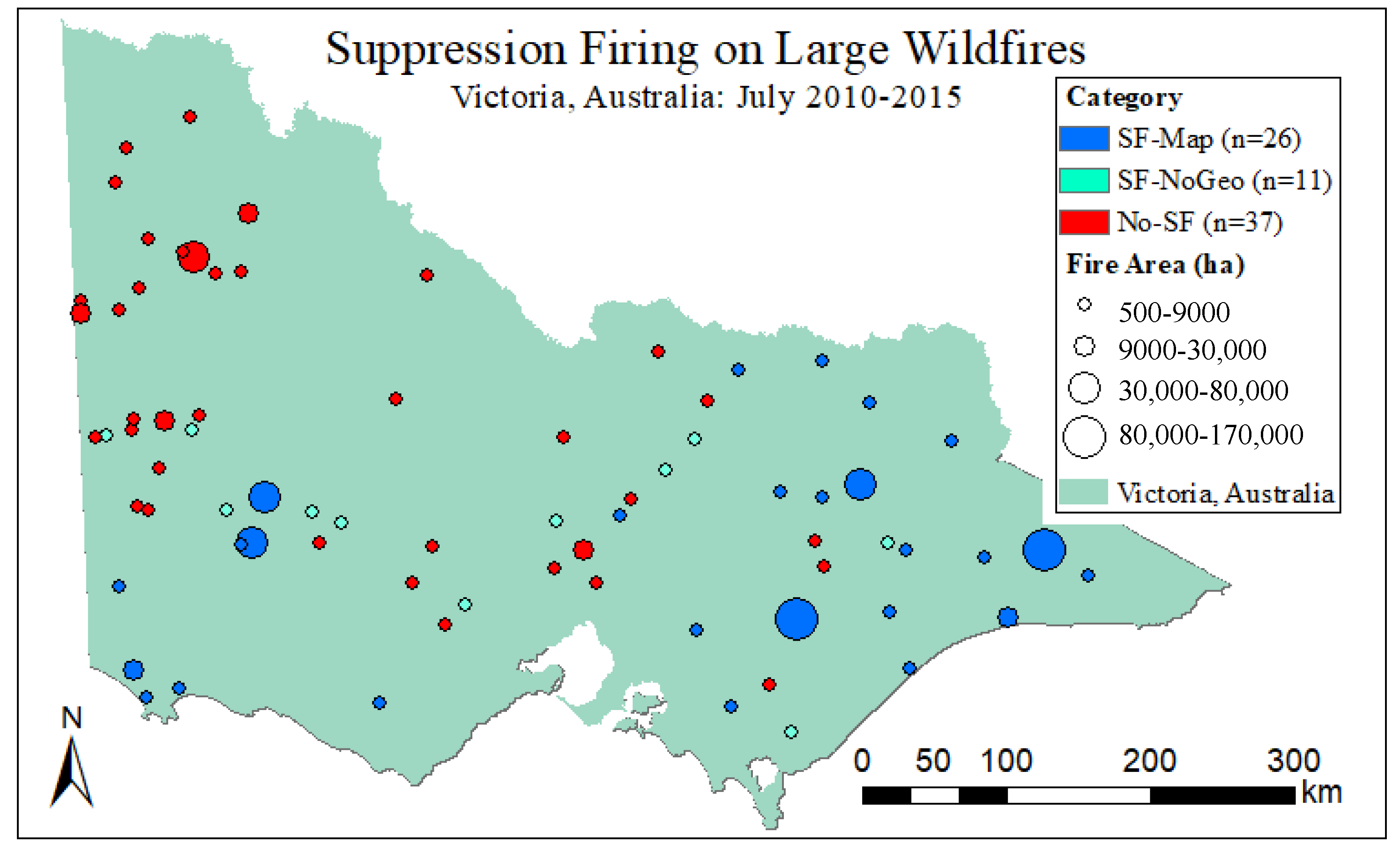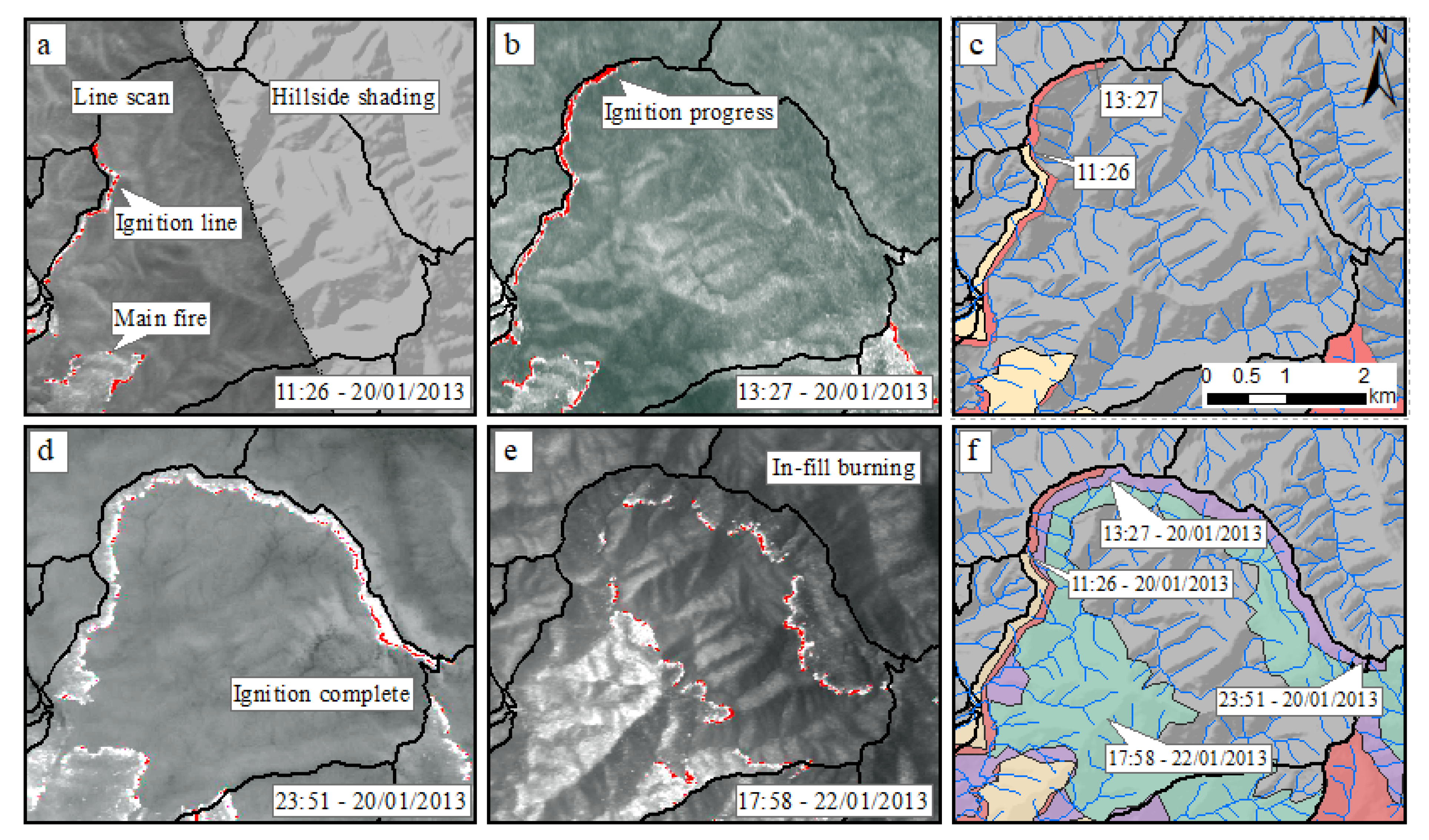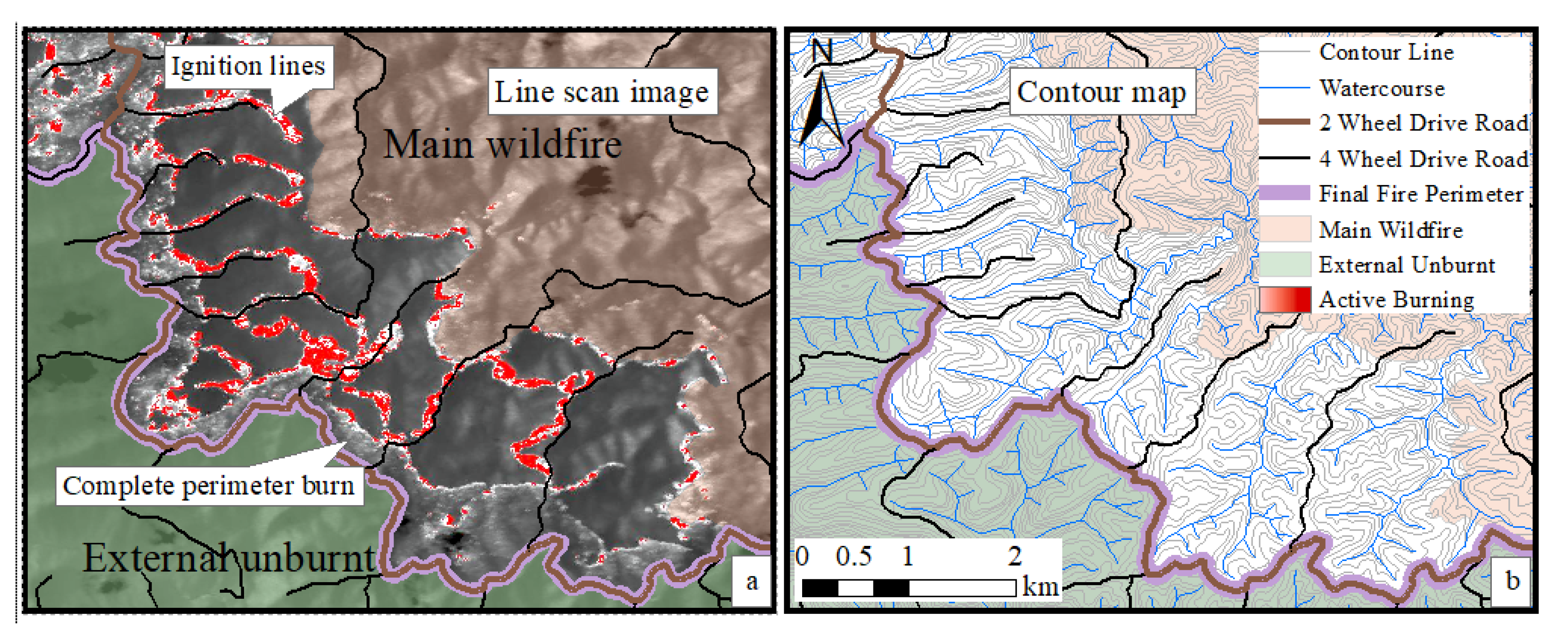Quantifying the Prevalence and Practice of Suppression Firing with Operational Data from Large Fires in Victoria, Australia
Abstract
:1. Introduction
1.1. Terminology
1.2. Issues with the Practice
2. Materials and Methods
2.1. Selected Fires and Data
2.2. Suppression Firing Reconstruction
2.3. Quantitative Analysis
3. Results
3.1. Proportion of Large Fires that Have Suppression Firing in Total and by Fuel Type
3.2. Proportion of External Perimeter Contained by Suppression Firing
3.3. Extent of Burn Area Attibutable to Suppression Firing
3.4. The Practice of Suppression Firing in Vicotria, Australia: Backburns and Burnouts
4. Discussion
Author Contributions
Funding
Institutional Review Board Statement
Data Availability Statement
Acknowledgments
Conflicts of Interest
References
- Vega, J.A.; Jiménez, E.; Dupuy, J.-L.; Linn, R.R. Effects of flame interaction on the rate of spread of heading and suppression fires in shrubland experimental fires. Int. J. Wildland Fire 2012, 21, 950–960. [Google Scholar] [CrossRef]
- Montiel, C.; Costa, P.; Galán, M. Towards Integrated Fire Management—Outcomes of the European Project Fire Paradox: Overview of Suppression Fire Policies and Practices in Europe; European Forest Institute: Porvoo, Finland, 2010. [Google Scholar]
- Ingalsbee, T. Ecological Fire Use for Ecological Fire Management: Managing Large Wildfires by Design. In Proceedings of the Large Wildland Fires Conference, Missoula, MT, USA, 19–23 May 2014; Department of Agriculture, Forest Service, Rocky Mountain Research Station: Missoula, MT, USA, 2015; pp. 120–127. [Google Scholar]
- Owens, D.; O’Kane, M. Final Report of the NSW Bushfire Inquiry; Department of Premier and Cabinet (NSW): Sydney, Australia, 2020. [Google Scholar]
- Gill, M.; Allan, G. Large fires, fire effects and the fire-regime concept. Int. J. Wildland Fire 2008, 17, 688. [Google Scholar] [CrossRef]
- Tedim, F.; Leone, V.; Amraoui, M.; Bouillon, C.; Coughlan, M.R.; Delogu, G.M.; Fernandes, P.M.; Ferreira, C.; McCaffrey, S.; McGee, T.K.; et al. Defining extreme wildfire events: Difficulties, challenges, and impacts. Fire 2018, 1, 9. [Google Scholar] [CrossRef] [Green Version]
- Filkov, A.I.; Duff, T.J.; Penman, T.D. Improving fire behaviour data obtained from wildfires. Forests 2018, 9, 81. [Google Scholar] [CrossRef] [Green Version]
- Strauss, D.; Bednar, L.; Mees, R. Do one percent of the forest fires cause ninety-nine percent of the damage? For. Sci. 1989, 35, 319–328. [Google Scholar] [CrossRef]
- Stocks, B.J.; Mason, J.A.; Todd, J.B.; Bosch, E.M.; Wotton, B.M.; Amiro, B.D.; Flannigan, M.D.; Hirsch, K.G.; Logan, K.A.; Martell, D.L.; et al. Large forest fires in Canada, 1959–1997. J. Geophys. Res. 2002, 107, 8149. [Google Scholar] [CrossRef]
- San-Miguel-Ayanz, J.; Moreno, J.M.; Camia, A. Analysis of large fires in European Mediterranean Landscapes: Lessons learned and perspectives. Forest Ecol. Manag. 2013, 294, 11–22. [Google Scholar] [CrossRef]
- Sandelowski, M. Whatever happened to qualitative description? Res. Nurs. Health 2000, 23, 334–340. [Google Scholar] [CrossRef]
- Australian Institute for Disaster Resilience Glossary. Available online: https://knowledge.aidr.org.au/glossary (accessed on 9 July 2020).
- Cooper, R.W. Preliminary Guidelines for Using Suppression Fires to Control Wildfires in the Southeast; USDA Forest Service: Asheville, NC, USA, 1969.
- Ingalsbee, T. Friendly Fire: Assessing the Effects of Firing Operations in Managing Wildfires. In Proceedings of the 3rd Fire Behavior and Fuels Conference, Washington, DC, USA, 25–29 October 2010; International Association of Wildland Fire: Spokane, Washington, DC, USA, 2010; pp. 1–7. [Google Scholar]
- Canadian Wildland Fire Management Glossary. Canadian Interagency Forest Fire Centre: Winnipeg, MB, Canada, 2017; Available online: https://www.ciffc.ca/sites/default/files/2019-03/CIFFC_Canadian_Wildland_Fire_Mgmt_Glossary_2017_10_24.pdf (accessed on 25 September 2021).
- Goldammer, J.G.; Ronde, C.D. Wildland Fire Management Handbook for Sub-Sahara Africa; Global Fire Monitoring Center: Freiburg im Breisgau, Germany, 2004; ISBN 978-1-919833-65-1. [Google Scholar]
- National Wildfire Coordinating Group. NWCG Glossary of Wildland Fire, PMS 205. Available online: https://www.nwcg.gov/glossary/a-z (accessed on 15 April 2020).
- Tsang, A.; Larson, K.; McAlpine, R. Resource Sharing for Control of Wildland Fires. In Proceedings of the Twenty-Seventh AAAI Conference on Artificial Intelligence, Washington, DC, USA, 14–18 July 2013; Bellevue: Washington, DC, USA, 2013; Volume 27, p. 7. [Google Scholar]
- Rural and Land Management Group. AFAC Bushfire Glossary; Australasian Fire Authorities Council: Melbourne, Victoria, Australia, 2012. [Google Scholar]
- Plucinski, M.P. Fighting flames and forging firelines: Wildfire suppression effectiveness at the fire edge. Curr. For. Rep. 2019, 5, 1–19. [Google Scholar] [CrossRef]
- Malloy, D.W. Backfire 2000 v. United States; Case 9:03-cv-00198-DWM Document 85. [Online]. 2006. Available online: http://www.coloradofirecamp.com/textdocuments/Backfire-2000-ruling-memo.pdf. (accessed on 1 July 2021).
- Kumagai, Y.; Bliss, J.C.; Daniels, S.E.; Carroll, M.S. Research on causal attribution of wildfire: An exploratory multiple-methods approach. Soc. Nat. Resour. 2004, 17, 113–127. [Google Scholar] [CrossRef]
- Canton-Thompson, J.; Gebert, K.M.; Thompson, B.; Jones, G.; Calkin, D.; Donovan, G. External human factors in incident management team Decisionmaking and their effect on large fire suppression expenditures. J. For. 2008, 106, 416–424. [Google Scholar]
- Bradshaw, K. Backfired! Distorted incentives in wildfire suppression. Utah Environ. Law Rev. 2012, 31, 155–179. [Google Scholar]
- Otero, I.; Nielsen, J.Ø. Coexisting with wildfire? Achievements and challenges for a radical social-ecological transformation in Catalonia (Spain). Geoforum 2017, 85, 234–246. [Google Scholar] [CrossRef]
- Rasmussen, J.H.; Fogarty, L.G. A Case Study of Grassland Fire Behaviour and Suppression: The Tikokino Fire of 31 January 1991; Forest and Rural Fire Science and Technical Series; New Zealand Forest Research Institute in association with the National Rural Fire Authority: Wellington, New Zealand, 1997; p. 26. [Google Scholar]
- Bearup, G. The thin brown line. Bush Fire Bulletin. 2014, 36, 58–65. [Google Scholar]
- Pascoe, S. The 2009 Victorian bushfires royal commission: Lessons for the conduct of inquiries in Australia. Aust. J. Public Adm. 2010, 69, 392–400. [Google Scholar] [CrossRef]
- A Nation Charred: Report on the Inquiry into Bushfires; Nairn, G. (Ed.) Commonwealth of Australia: Canberra, Australia, 2003; ISBN 978-0-642-78445-2. [Google Scholar]
- Inspector General for Emergency Management. Review of the Initial Response to the 2015 Wye River—Jamieson Track Fire; Victoria State Government: Melbourne, Australia, 2016; ISBN 978-0-9944237-5-7.
- Simpson, H.; Bradstock, R.; Price, O. A temporal framework of large wildfire suppression in practice, a qualitative descriptive study. Forests 2019, 10, 884. [Google Scholar] [CrossRef] [Green Version]
- DELWP Powelltown_Learmonth_20140209_2329_SitRep_19. Unpublished Data. 2014.
- DELWP Timbarra_GilGroggin_20140218_0940_SitRep_19. Unpublished Data. 2014.
- DELWP Corryong_Kings_Creek_20140119_0550_SitRep_12. Unpublished Data. 2014.
- DELWP Kentbruck_Portland_20130109_Night_IAP_11. Unpublished Data. 2013.
- Gould, J.; Cruz, M. Australian Fuel Classification: Stage II; Ecosystem Sciences and Climate Adaption Flagship, CSIRO: Canberra, Australia, 2012; p. 108. [Google Scholar]
- Storey, M.A.; Price, O.F.; Sharples, J.J.; Bradstock, R.A. Drivers of long-distance spotting during wildfires in South-Eastern Australia. Int. J. Wildland Fire 2020. [Google Scholar] [CrossRef]
- Finney, M.A.; McAllister, S.S. A review of fire interactions and mass fires. J. Combust. 2011, 2011, 1–14. [Google Scholar] [CrossRef]
- Cui, W.; Qiao, Q. Experimental studies of interactions between backfires and coming surface fires. For. Stud. China 2002, 4, 25–28. [Google Scholar]
- McRae, D.J.; Jin, J.-Z.; Conard, S.G.; Sukhinin, A.I.; Ivanova, G.A.; Blake, T.W. Infrared characterization of fine-scale variability in behavior of boreal forest fires. Can. J. For. Res. 2005, 35, 2194–2206. [Google Scholar] [CrossRef]
- Morvan, D.; Meradji, S.; Mell, W. Interaction between head fire and backfire in grasslands. Fire Saf. J. 2013, 58, 195–203. [Google Scholar] [CrossRef]
- DELWP Aberfeldy_20130120_02:38_SitRep_24. Unpublished Data. 2013.
- Olsen, C.F. An analysis of the honey fire. Fire Control. Notes 1941, 5, 161–178. [Google Scholar]
- Giglio, L.; Loboda, T.; Roy, D.P.; Quayle, B.; Justice, C.O. An active-fire based burned area mapping algorithm for the MODIS sensor. Remote Sens. Environ. 2009, 113, 408–420. [Google Scholar] [CrossRef]
- Jordan, G.J.; Fortin, M.-J.; Lertzman, K.P. Spatial pattern and persistence of historical fire boundaries in southern interior British columbia. Environ. Ecol. Stat. 2008, 15, 523–535. [Google Scholar] [CrossRef]
- Price, O.F.; Bradstock, R.A. The effect of fuel age on the spread of fire in Sclerophyll Forest in the Sydney region of Australia. Int. J. Wildland Fire 2010, 19, 35–45. [Google Scholar] [CrossRef] [Green Version]
- Narayanaraj, G.; Wimberly, M.C. Influences of forest roads on the spatial pattern of wildfire boundaries. Int. J. Wildland Fire 2011, 20, 792–803. [Google Scholar] [CrossRef]
- DELWP Grampians_Northern_20140118_1243_SitRep_12. Unpublished Data. 2014.
- Backer, D.M.; Jensen, S.E.; McPherson, G.R. Impacts of fire-suppression activities on natural communities. Conserv. Biol. 2004, 18, 937–946. [Google Scholar] [CrossRef]
- Plucinski, M.P. Contain and control: Wildfire suppression effectiveness at incidents and across landscapes. Curr. For. Rep. 2019, 5, 20–40. [Google Scholar] [CrossRef]





| Term | Definition |
|---|---|
| Suppression Firing 1 | The intentional application of fire for containment or control purposes during an unplanned fire event. Suppression firing used as an overarching term to encompass all firing operations (e.g., backburns, burnouts, and counter-fires). |
| Backburn 2 | “A fire started intentionally from a prepared line or other barrier to burn an area of flammable material in the path of an advancing fire in order to control that fire.” |
| Burnout 2 | “A fire set to consume islands of unburnt fuel inside the fire perimeter and between the fire edge and fireline.” |
| Counter-fire 1 | Suppression fire that: (a) occurs in the path, or near the projected path of a rapidly spreading fire, and; (b) results in a purposeful interaction to draw the counter-fire into the primary fire, or; (c) causes a significant interaction that changes the primary fire’s direction of spread. |
| Source | Term | Definition |
|---|---|---|
| Australia [12] | Backburn | “1. A fire started intentionally along the inner edge of a fireline during indirect attack operations to consume fuel in the path of a bushfire (Australia).” 2. “A counterfire commenced from within continuous fuel for the purpose of fighting a fire (New Zealand).” |
| Back burn | “A fire started intentionally from a prepared line or other barrier to burn an area of flammable material in the path of an advancing fire in order to control that fire.” | |
| Burn out | “1. A fire set to consume islands of unburnt fuel inside the fire perimeter and between the fire edge and fireline (Australia). 2. A counterfire commenced from a natural or previously constructed firebreak for the purpose of fighting a fire (New Zealand).” | |
| USA [17] (current) | Suppression firing | “The intentional application of fire to speed or strengthen control action on free-burning fires. Types of suppression firing include burning out, counter firing, and strip burning.” |
| Burning out | “Setting fire inside a control line to consume fuel between the edge of the fire and the control line.” | |
| Counter fire | “(1) Fire set between main fire and backfire to hasten spread of backfire. (2) Emergency firing to stop, delay, or split a fire front, or to steer a fire.” | |
| Strip burning | “Burning by means of strip firing.” | |
| Strip firing | “Setting fire to more than one strip of fuel and providing for the strips to burn together. Frequently done in burning out against a wind where inner strips are fired first to create drafts which pull flames and sparks away from the control line.” | |
| Backfire | “A fire set along the inner edge of a fireline to consume the fuel in the path of a fire or change the direction of force of the fire’s convection column.” | |
| Backfiring | “A tactic associated with indirect attack, intentionally setting fire to fuels inside the control line to slow, knock down, or contain a rapidly spreading fire. Backfiring provides a wide defense perimeter and may be further employed to change the force of the convection column.” | |
| USA [13] (p. 1) (1969) | Suppression firing | “The intentional application of fire to speed or strengthen control action on free-burning fires, suppression firing includes the following classifications: (1) counter firing, (2) burning out, (3) mopup burning.” |
| Counter firing | “Emergency firing in or near the projected path of a steady, high-intensity fire for the purpose of splitting or delaying the fire front, or to steer the fire in a desired direction.” | |
| Burning out | “The use of fire to widen control lines and to remove islands or wide strips of unburned fuel within control lines.” | |
| Mop-up burning | “The use of fire during the final stages of control efforts to remove islands of unburned fuel or extend the ‘black line’ of control.” |
| Activity | SitRep Excerpt | Fire Name |
|---|---|---|
| Preparation | “Machines tasked to brush up control lines to the north and south of fire ahead of expected backburning operations [32].” | Powelltown |
| Status | “Crews continuing to patrol and black out, Several hot spots are showing up around the area, with the main fire becoming more active—though not threatening lines—backburn and main fire are yet to converge—they should meet during today [33].” | Timbarra |
| Progress | “Crews have burnt out along the Eustace Gap Tk to the north to keep in front of active edge. Burning continued to approx. EV667442. South along Eustace Gap Tk burning extended to EV652411 [34].” | Corryong |
| Extent | “Cobboboonee Division Indirect attack involves completion of a backburn along Inkpot Rd, Heath Rd and South Kentbruck Tk a distance of approximately 20 km [35].” | Kentbruck |
| Category | Count | Min (ha) | Max (ha) | Mean (ha) | Median (ha) | StdDev (ha) | Sum (ha) |
|---|---|---|---|---|---|---|---|
| SF-Map | 26 | 544 | 165,811 | 17,431 | 2850 | 36,506 | 453,208 |
| SF-NoGeo | 11 | 684 | 5518 | 2438 | 1818 | 1709 | 26,823 |
| No-SF | 37 | 508 | 56,544 | 5190 | 1210 | 10,732 | 192,022 |
| Total | 74 | 508 | 165,811 | 9082 | 1566 | 23,511 | 672,053 |
| Fuel Type | SF-Map | SF-No-Geo | No-SF | Total |
|---|---|---|---|---|
| Forest | 13 | 3 | 1 | 17 |
| Heath | 6 | 0 | 1 | 7 |
| Woodland | 4 | 2 | 5 | 11 |
| Grassland | 3 | 4 | 12 | 19 |
| Mallee | 0 | 2 | 18 | 20 |
| Total | 26 | 11 | 37 | 74 |
Publisher’s Note: MDPI stays neutral with regard to jurisdictional claims in published maps and institutional affiliations. |
© 2021 by the authors. Licensee MDPI, Basel, Switzerland. This article is an open access article distributed under the terms and conditions of the Creative Commons Attribution (CC BY) license (https://creativecommons.org/licenses/by/4.0/).
Share and Cite
Simpson, H.; Bradstock, R.; Price, O. Quantifying the Prevalence and Practice of Suppression Firing with Operational Data from Large Fires in Victoria, Australia. Fire 2021, 4, 63. https://0-doi-org.brum.beds.ac.uk/10.3390/fire4040063
Simpson H, Bradstock R, Price O. Quantifying the Prevalence and Practice of Suppression Firing with Operational Data from Large Fires in Victoria, Australia. Fire. 2021; 4(4):63. https://0-doi-org.brum.beds.ac.uk/10.3390/fire4040063
Chicago/Turabian StyleSimpson, Heather, Ross Bradstock, and Owen Price. 2021. "Quantifying the Prevalence and Practice of Suppression Firing with Operational Data from Large Fires in Victoria, Australia" Fire 4, no. 4: 63. https://0-doi-org.brum.beds.ac.uk/10.3390/fire4040063






